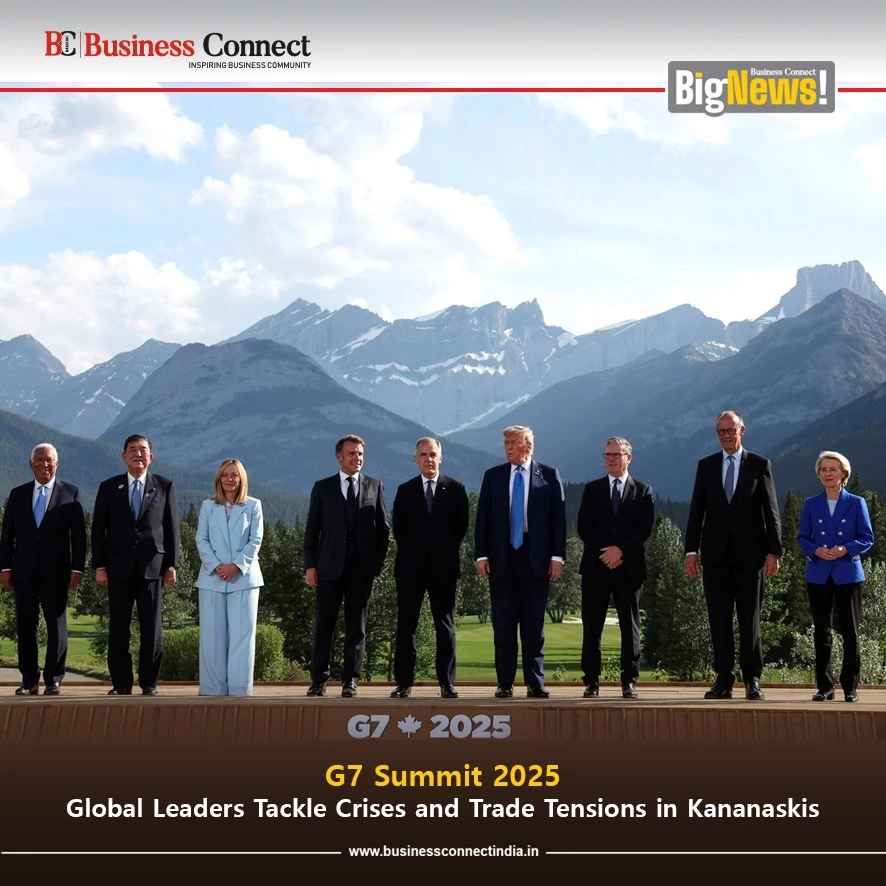By Business Connect Magazine
The 51st G7 Summit, hosted by Canada in the scenic Kananaskis, Alberta, from June 15-17, 2025, has concluded with a whirlwind of discussions, overshadowed by geopolitical tensions and U.S. President Donald Trump’s early departure. As global leaders gathered to address pressing issues like the Israel-Iran conflict, the Russia-Ukraine war, and trade disputes, the summit underscored both the challenges and opportunities facing the world’s major economies. Here’s a deep dive into the key moments, outcomes, and implications of this landmark event.
G7 Summit 2025: Global Leaders Tackle Crises and Trade Tensions in Kananaskis
A Summit Amidst Global Crises
The G7 Summit, attended by leaders from Canada, France, Germany, Italy, Japan, the United Kingdom, and the United States, along with the European Union and invited nations like India, Australia, Mexico, Ukraine, and others, was a critical platform for addressing global challenges.
Canadian Prime Minister Mark Carney, hosting his first G7 as leader, set an ambitious agenda focusing on three core priorities: protecting communities, building energy security, and securing future partnerships. However, escalating tensions in the Middle East and Trump’s trade policies dominated the conversations.
The Israel-Iran conflict took center stage, with leaders expressing support for Israel’s right to defend itself while condemning Iran as a source of regional instability. A joint statement emphasized that Iran must not acquire nuclear weapons, reflecting unified concern over escalating tensions. French President Emmanuel Macron claimed Trump proposed a ceasefire offer, a claim Trump later denied, stating his early exit on June 16 was for a “much bigger” move related to the Middle East crisis.
The Russia-Ukraine war also loomed large. Trump’s overt support for Russian President Vladimir Putin and his suggestion that Russia’s exclusion from the G7 was a mistake stirred controversy, highlighting divisions among members. The G7’s struggle to find unity on Ukraine, compounded by Trump’s tariff policies, made consensus elusive, leading organizers to forgo a traditional joint communiqué in favor of shorter, action-oriented statements.
Trade Tensions and Economic Priorities
Trump’s aggressive trade policies, including blanket tariffs on allies, cast a shadow over discussions on the global economy. Describing himself as a “tariff person,” Trump’s focus on trade underscored his intent to reshape economic relationships, raising concerns among G7 allies about weakened economies and a strengthened China. Despite these tensions, a significant win emerged for Canada: Trump agreed to negotiate a new economic and security deal with the U.S. by mid-July, a potential step toward reducing Canada’s dependency on its southern neighbor.
Energy security and digital transition were also key agenda items. Indian Prime Minister Narendra Modi, attending his sixth consecutive G7 as a guest, emphasized energy diversification, technology, and infrastructure, while advocating for the Global South’s priorities. His bilateral meetings, including with Carney, aimed to strengthen India-Canada ties amidst recent diplomatic strains.
Mark Carney’s Diplomatic Test
For Carney, the summit was a high-stakes debut on the global stage. His strategy to “Trump-proof” the event—fewer plenary sessions, more bilateral meetings, and no joint communiqué—aimed to mitigate disruptions. Despite challenges, Carney secured a commitment for U.S.-Canada trade talks and navigated the summit without the public fallout seen in 2018, when Trump clashed with then-Prime Minister Justin Trudeau.
Experts, including John Kirton of the G7 Research Group, praised Carney’s ability to treat Trump as an equal while advancing Canada’s goals.
Key Highlights and Sideline Engagements
Bilateral Breakthroughs: Trump held talks with Ukrainian President Volodymyr Zelenskyy and Mexico’s President Claudia Sheinbaum Pardo, while Modi’s presence reinforced India’s growing global influence. UK Prime Minister Keir Starmer secured a deal with Trump on car tariffs and aerospace, calling it a “very important day” for both nations.
Security Measures: Strict security, including restricted airspace and designated protest zones, ensured safety in Kananaskis. Protests were livestreamed to leaders, a modern twist on public engagement.Global Guests: The inclusion of leaders from Brazil, South Africa, South Korea, and others highlighted the G7’s outreach to emerging economies, with Modi’s attendance signaling India’s strategic importance.
Looking Ahead: Implications for Global Business
The 2025 G7 Summit underscored the fragility of global cooperation amid rising geopolitical and economic tensions. For businesses, Trump’s tariffs signal potential disruptions in supply chains and trade flows, particularly for G7 nations reliant on U.S. markets. However, opportunities lie in Canada’s push for energy security and digital innovation, which could spur investments in renewable energy and tech infrastructure. Modi’s focus on the Global South also highlights emerging markets as key growth areas for businesses seeking diversification.
As the G7 presidency rotates and global leaders prepare for upcoming summits, including NATO’s meeting in Europe, the outcomes of Kananaskis will shape economic and diplomatic strategies. For now, the world watches as leaders navigate an increasingly complex global landscape, with trade, security, and stability hanging in the balance.
Stay tuned to Business Connect Magazine for more insights on global leadership and economic trends.
Add Business Connect magazine to your Google News feed


